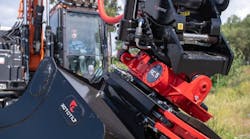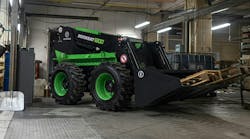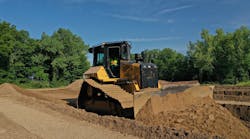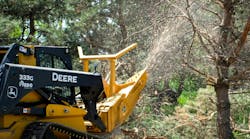Owners of crawler loaders larger than 105 horsepower spend about half of their original purchase price, on average, for repair parts and labor over the life of the loader. Only 15 percent of owners spend 75 to 99 percent of first cost on repairs, and 8 percent of owners spend 100 or more percent of purchase price on repairs.
Carefully managed undercarriage, and its lower cost, seems to support this reasonable repair-cost experience for a tracked machine that routinely works hard for 10,000 hours or more.
A significant portion of the Construction Equipment Reader Advisory Board, a select group of contractors committed to accurate control of equipment costs, seems to have successfully mitigated the effects of premature undercarriage wear. Eighty percent of our reader advisors turn track-chain pins and bushings as part of their regular undercarriage maintenance program. Half of them are able to take full advantage of pin and bushing life before the turn most of the time. That kind of consistency tends to control track costs.
Operating conditions seem to favor long undercarriage life. The average machine operated by our reader advisors works 34 percent of its hours on relatively forgiving soil, gravel and turf. It works about 15 percent of the time in rocky soil and 17 percent on asphalt or concrete pavement. Advisory board machines only endure about 10 percent of their working hours in demolition debris or shot rock.
On average, crawler loaders larger than 105 horsepower draw 27 percent of their original purchase price in resale. But while the bulk of crawler loaders resell for less than 35 percent of their original investment, a significant portion of reader advisors (28 percent) realizes in the neighborhood of 50 percent resale value (35 to 65 percent).
Sixty-eight percent of respondents to the crawler-loader survey are highway and heavy constructors and are based in 21 states, evenly disbursed in all regions of the country. Fleet-replacement values are fairly evenly spread from $5 million to more than $100 million.
Common Causes of Early Track FailureWe asked crawler-loader owners to tell us about the most common causes of premature undercarriage failure. Most of the answers fit under three categories. These examples sum up their advice:
Maintenance
"Not maintaining proper track tension"
"Lack of preventative maintenance on the operator side"
"Not being cleaned on a daily basis"
"We have our Caterpillar dealer measure our undercarriage routinely. So we rarely have premature failure"
Operation
"Inexperienced and reckless operators are considered a factor"
"High speed backing"
"Spinning tracks"
"Abuse"
Conditions
"Rock excavation"
"Foreign objects; point loading of undercarriage on uneven demolition debris"
"Sand"
"Mud and water"
Advice To Improve Track LifeWe asked crawler-loader owners to tell us their most effective method for improving undercarriage life. More than 62 percent of the answers focused on improved preventive maintenance. These examples sum up their advice:
"Daily cleaning and inspection"
"Monitor adjustment and change sprockets at the appropriate time BEFORE pin and bushing turn is required"
"Regular track inspections with measurements for wear"
Most of the remaining answers dealt with improving operations, such as:
"Continuously checking tracks, limiting the amount of unnecessary turns"
"Locking out the higher-speed reverse gear"
"Teaching employees the Do's and Don’ts to keep the machine lasting longer"
And there was some outright brand partisanship:
"Switching to Cat bottoms, initially for the support but now we recognize substantial gains in our undercarriage life and reduction in cost per hour"
Reader Advisory Board research is co-sponsored by Case Construction Equipment.






